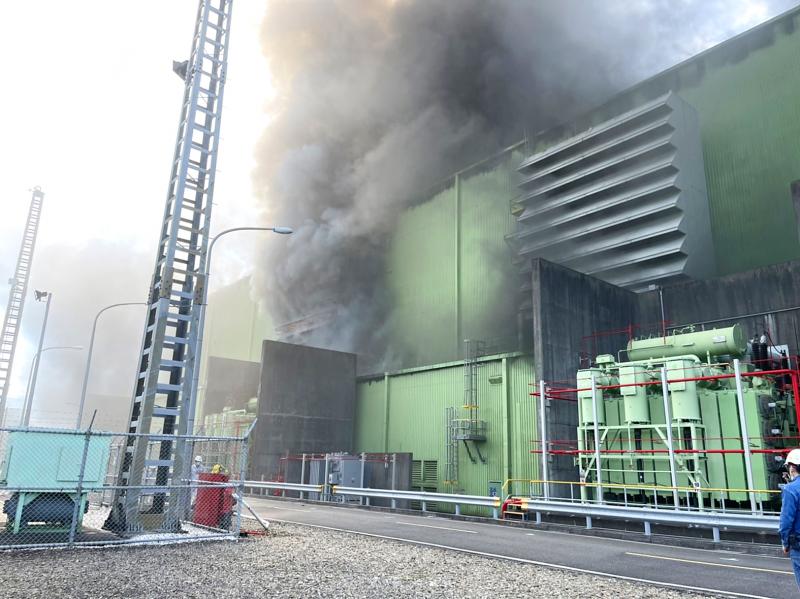A fire that broke out yesterday morning at Hsin Tao Power Corp (新桃電力) in Hsinchu County’s Guansi Township (關西) has been extinguished, the local fire department said.
The fire did not cause any power supply problems or injuries, it added.
The blaze was brought under control at about 11am, less than two hours after firefighters were dispatched to the scene, and by 11:48am the fire had been extinguished, it said.

Photo courtesy of Hsinchu County Government Fire Bureau
Losses from the fire were estimated at about NT$300 million (US$10.52 million), it said, adding that the cause of the blaze had not yet been determined and was still being investigated.
At a meeting of the legislature’s Economics Committee later in the day, Minister of Economic Affairs Wang Mei-hua (王美花) said the fire did not cause any power outages or electricity supply problems in the Hsinchu area, as Taiwan Power Co (Taipower, 台電) had activated standby generators to deal with the problem.
Hsin Tao was established in June 1998 as a private company, with the goal of helping to alleviate the long-term power shortage in northern Taiwan.
At full capacity, the generators at the combined-cycle power plant are capable of generating 14.4 million gigawatt-hours per day, supplying 1.2 percent of the nation’s power needs.
The plant supplies Taipower with 9 gigawatt-hours of electricity per day. The fire affected the generation of about 600,000 kilowatt-hours, Taipower said.
Separately, Taipower has requested NT$100 billion to improve grid resilience, following a nationwide power outage on March 3 that affected more than 5 million households.
Deputy Minister of Economic Affairs Tseng Wen-sheng (曾文生), Taipower’s interim chairman, on Thursday said that the funding would also be used to reduce overconcentration on certain parts of the grid.
For instance, power plants can distribute electricity separately to heavy users in need of stable power supply, such as science or industrial parks, instead of transmitting it through mainline connections serving households, he said.
The ministry plans to trial the new mechanism at the Southern Taiwan Science Park (南部科學園區), and will work with the Ministry of Science and Technology to learn about the park’s power consumption patterns to ensure more efficient operations, he added.

Taiwan Semiconductor Manufacturing Co (TSMC, 台積電) last week recorded an increase in the number of shareholders to the highest in almost eight months, despite its share price falling 3.38 percent from the previous week, Taiwan Stock Exchange data released on Saturday showed. As of Friday, TSMC had 1.88 million shareholders, the most since the week of April 25 and an increase of 31,870 from the previous week, the data showed. The number of shareholders jumped despite a drop of NT$50 (US$1.59), or 3.38 percent, in TSMC’s share price from a week earlier to NT$1,430, as investors took profits from their earlier gains

In a high-security Shenzhen laboratory, Chinese scientists have built what Washington has spent years trying to prevent: a prototype of a machine capable of producing the cutting-edge semiconductor chips that power artificial intelligence (AI), smartphones and weapons central to Western military dominance, Reuters has learned. Completed early this year and undergoing testing, the prototype fills nearly an entire factory floor. It was built by a team of former engineers from Dutch semiconductor giant ASML who reverse-engineered the company’s extreme ultraviolet lithography (EUV) machines, according to two people with knowledge of the project. EUV machines sit at the heart of a technological Cold

Taiwan’s long-term economic competitiveness will hinge not only on national champions like Taiwan Semiconductor Manufacturing Co. (TSMC, 台積電) but also on the widespread adoption of artificial intelligence (AI) and other emerging technologies, a US-based scholar has said. At a lecture in Taipei on Tuesday, Jeffrey Ding, assistant professor of political science at the George Washington University and author of "Technology and the Rise of Great Powers," argued that historical experience shows that general-purpose technologies (GPTs) — such as electricity, computers and now AI — shape long-term economic advantages through their diffusion across the broader economy. "What really matters is not who pioneers

TAIWAN VALUE CHAIN: Foxtron is to fully own Luxgen following the transaction and it plans to launch a new electric model, the Foxtron Bria, in Taiwan next year Yulon Motor Co (裕隆汽車) yesterday said that its board of directors approved the disposal of its electric vehicle (EV) unit, Luxgen Motor Co (納智捷汽車), to Foxtron Vehicle Technologies Co (鴻華先進) for NT$787.6 million (US$24.98 million). Foxtron, a half-half joint venture between Yulon affiliate Hua-Chuang Automobile Information Technical Center Co (華創車電) and Hon Hai Precision Industry Co (鴻海精密), expects to wrap up the deal in the first quarter of next year. Foxtron would fully own Luxgen following the transaction, including five car distributing companies, outlets and all employees. The deal is subject to the approval of the Fair Trade Commission, Foxtron said. “Foxtron will be